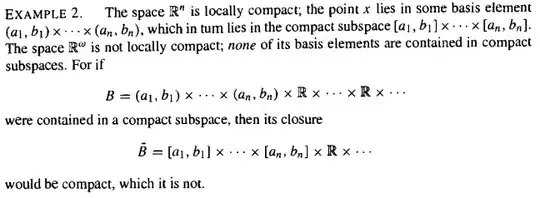From section 29 of Munkres' topology. The bar on top of the 'B' indicates that it is the closure of B. The example above assumes that $\mathbb{R}^{\omega}$ is in the product topology with respect to the standard topology of $\mathbb{R}$.
My understanding: To derive a contradiction for the local compactness of $\mathbb{R}$, the proof uses the fact that a closed set of a compact space is compact. Furthermore, if X is a compact space in Y and Y is a compact space in Z, then X is a compact space in Z. If we show that X (in this case, the closure of B) is not compact in Z ($\mathbb{R}^{\omega}$), then we have proven that $\mathbb{R}^{\omega}$ is not locally compact. This part follows from the fact that $\mathbb{R}^{\omega}$ is not compact.
My logic gap: The proof that none of $\mathbb{R}^{\omega}$'s basis elements is contained in a compact subspace seems to rely on the assumption that, if B lies in compact subspace C, then the closure of B also lies in C. To me, this seems to be the only way the above logic can be applied to arrive at the subsequent contradiction, but I can't see any obvious way to prove this.
Am I thinking about this wrong? Any proofs or guiding hints would be much appreciated.
